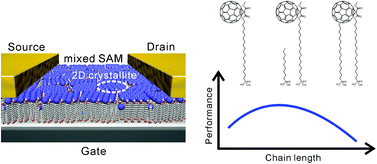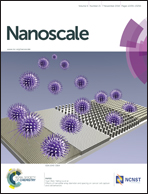Tuning the molecular order of C60-based self-assembled monolayers in field-effect transistors†
Abstract
The control of order in organic semiconductor systems is crucial to achieve desired properties in electronic devices. We have studied the order in fullerene functionalized self-assembled monolayers by mixing the active molecules with supporting alkyl phosphonic acids of different chain length. By adjusting the length of the molecules, structural modifications of the alignment of the C60 head groups within the SAM can be tuned in a controlled way. These changes on the sub-nanometre scale were analysed by grazing incidence X-ray diffraction and X-ray reflectivity. To study the electron transport properties across these layers, self-assembled monolayer field-effect transistors (SAMFETs) were fabricated containing only the single fullerene monolayer as semiconductor. Electrical measurements revealed that a high 2D crystalline order is not the only important aspect. If the fullerene head groups are too confined by the supporting alkyl phosphonic acid molecules, defects in the crystalline C60 film, such as grain boundaries, start to strongly limit the charge transport properties. By close interpretation of the results of structural investigations and correlating them to the results of electrical characterization, an optimum chain length of the supporting alkyl phosphonic acids in the range of C10 was determined. With this study we show that minor changes in the order on the sub-nanometre scale, can strongly influence electronic properties of functional self-assembled monolayers.


 Please wait while we load your content...
Please wait while we load your content...